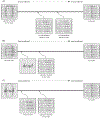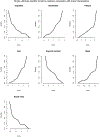Estimation of a Preference-Based Summary Score for the Patient-Reported Outcomes Measurement Information System: The PROMIS®-Preference (PROPr) Scoring System
- PMID: 29944456
- PMCID: PMC6502464
- DOI: 10.1177/0272989X18776637
Estimation of a Preference-Based Summary Score for the Patient-Reported Outcomes Measurement Information System: The PROMIS®-Preference (PROPr) Scoring System
Abstract
Background: Health-related quality of life (HRQL) preference-based scores are used to assess the health of populations and patients and for cost-effectiveness analyses. The National Institutes of Health Patient-Reported Outcomes Measurement Information System (PROMIS®) consists of patient-reported outcome measures developed using item response theory. PROMIS is in need of a direct preference-based scoring system for assigning values to health states.
Objective: To produce societal preference-based scores for 7 PROMIS domains: Cognitive Function-Abilities, Depression, Fatigue, Pain Interference, Physical Function, Sleep Disturbance, and Ability to Participate in Social Roles and Activities.
Setting: Online survey of a US nationally representative sample ( n = 983).
Methods: Preferences for PROMIS health states were elicited with the standard gamble to obtain both single-attribute scoring functions for each of the 7 PROMIS domains and a multiplicative multiattribute utility (scoring) function.
Results: The 7 single-attribute scoring functions were fit using isotonic regression with linear interpolation. The multiplicative multiattribute summary function estimates utilities for PROMIS multiattribute health states on a scale where 0 is the utility of being dead and 1 the utility of "full health." The lowest possible score is -0.022 (for a state viewed as worse than dead), and the highest possible score is 1.
Limitations: The online survey systematically excludes some subgroups, such as the visually impaired and illiterate.
Conclusions: A generic societal preference-based scoring system is now available for all studies using these 7 PROMIS health domains.
Keywords: PROMIS; US general population; health utility; health-related quality of life.
Figures






Similar articles
-
Cross-sectional validation of the PROMIS-Preference scoring system.PLoS One. 2018 Jul 31;13(7):e0201093. doi: 10.1371/journal.pone.0201093. eCollection 2018. PLoS One. 2018. PMID: 30063733 Free PMC article.
-
Computing PROPr Utility Scores for PROMIS® Profile Instruments.Value Health. 2020 Mar;23(3):370-378. doi: 10.1016/j.jval.2019.09.2752. Epub 2019 Dec 30. Value Health. 2020. PMID: 32197733 Free PMC article.
-
Comparison of the PROMIS Preference Score (PROPr) and EQ-5D-5L Index Value in General Population Samples in the United Kingdom, France, and Germany.Value Health. 2022 May;25(5):824-834. doi: 10.1016/j.jval.2021.10.012. Epub 2021 Dec 15. Value Health. 2022. PMID: 35500951
-
Patient-Reported Outcomes Measurement Information System Versus Legacy Instruments: Are They Ready for Prime Time?Rheum Dis Clin North Am. 2019 May;45(2):211-229. doi: 10.1016/j.rdc.2019.01.006. Rheum Dis Clin North Am. 2019. PMID: 30952394 Review.
-
Relationship between psychometric and utility-based approaches to the measurement of health-related quality of life.Qual Life Res. 1993 Dec;2(6):477-87. doi: 10.1007/BF00422222. Qual Life Res. 1993. PMID: 8161982 Review.
Cited by
-
Comparison of the EQ-5D-5L and the patient-reported outcomes measurement information system preference score (PROPr) in the United States.J Patient Rep Outcomes. 2024 Jul 19;8(1):76. doi: 10.1186/s41687-024-00749-1. J Patient Rep Outcomes. 2024. PMID: 39028485 Free PMC article.
-
Hungarian PROMIS-29+2: psychometric properties and population reference values.Qual Life Res. 2023 Aug;32(8):2179-2194. doi: 10.1007/s11136-023-03364-7. Epub 2023 Feb 15. Qual Life Res. 2023. PMID: 36792819 Free PMC article.
-
The use of PROMIS patient-reported outcomes (PROs) to inform light chain (AL) amyloid disease severity at diagnosis.Amyloid. 2020 Jun;27(2):111-118. doi: 10.1080/13506129.2020.1713743. Epub 2020 Jan 23. Amyloid. 2020. PMID: 31971467 Free PMC article.
-
A scoping review to create a framework for the steps in developing condition-specific preference-based instruments de novo or from an existing non-preference-based instrument: use of item response theory or Rasch analysis.Health Qual Life Outcomes. 2024 May 14;22(1):38. doi: 10.1186/s12955-024-02253-y. Health Qual Life Outcomes. 2024. PMID: 38745165 Free PMC article.
-
Health economic evaluation of trans-tibial prosthetic suspension systems: a protocol for a pilot using an observational study and synthetic cohort.Cost Eff Resour Alloc. 2025 Apr 12;23(1):15. doi: 10.1186/s12962-025-00611-1. Cost Eff Resour Alloc. 2025. PMID: 40221702 Free PMC article.
References
-
- Torrance GW, Feeny D, Furlong WJ, Barr RD, Zhang Y, Wang Q. Multiattribute utility function for a comprehensive health status classification system: Health Utilities Index Mark 2. Med Care. 1996;34(7):702–22. - PubMed
-
- Feeny D, Furlong W, Torrance GW, Goldsmith CH, Zhu Z, DePauw S, et al. Multiattribute and single-attribute utility functions for the Health Utilities Index Mark 3 system. Med Care. 2002;40(2):113–28. - PubMed
-
- EuroQol Group. EuroQol -- A new facility for the measurement of health related quality of life. Health Policy (New York). 1990;(16):199–208. - PubMed
-
- Kaplan RM, Anderson JP. The Quality of Well-Being Scale: rationale for a single quality of life index. Qual Life Assessement Appl. 1995;51–77.
Publication types
MeSH terms
Grants and funding
LinkOut - more resources
Full Text Sources
Other Literature Sources
Medical

